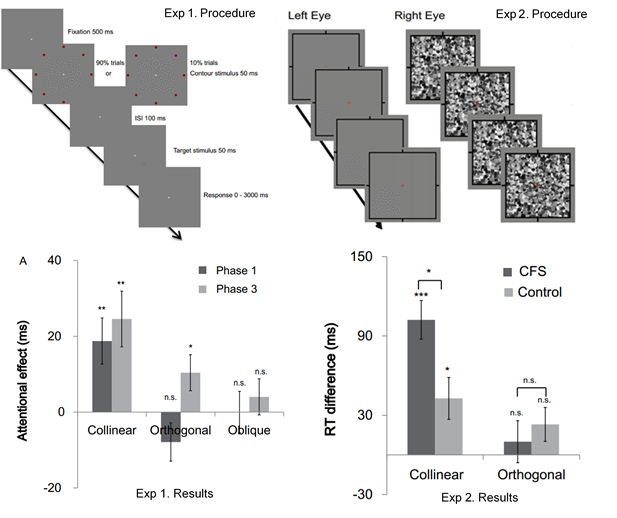 Previous literature suggests that low-level stimulus properties determine the detection performance of contours and are used to define different contour types. Sheng Li’s group investigated the processing of different types of contours under conscious and unconscious conditions. In Experiment 1, we adopted an inattentional blindness paradigm and showed that collinear contours (i.e., a contour type that is frequently observed in natural images) induced a positive cueing effect in both the conscious and unconscious conditions, whereas orthogonal contours (which are less prevalent in the natural environment) attracted attention only when consciously perceived. In Experiment 2, we showed that collinear contours rendered invisible by continuous flash suppression emerged from suppression more rapidly than a random field, whereas orthogonal contours had no such breaking superiority. These results suggest that collinear but not orthogonal contours can be processed and serve as attentional cues without conscious awareness. Their findings provide further evidence that the relevance of the contours to natural statistics could be a key evolutionary factor that decides whether a contour can be unconsciously processed to increase its detectability in a clutter environment.
Previous literature suggests that low-level stimulus properties determine the detection performance of contours and are used to define different contour types. Sheng Li’s group investigated the processing of different types of contours under conscious and unconscious conditions. In Experiment 1, we adopted an inattentional blindness paradigm and showed that collinear contours (i.e., a contour type that is frequently observed in natural images) induced a positive cueing effect in both the conscious and unconscious conditions, whereas orthogonal contours (which are less prevalent in the natural environment) attracted attention only when consciously perceived. In Experiment 2, we showed that collinear contours rendered invisible by continuous flash suppression emerged from suppression more rapidly than a random field, whereas orthogonal contours had no such breaking superiority. These results suggest that collinear but not orthogonal contours can be processed and serve as attentional cues without conscious awareness. Their findings provide further evidence that the relevance of the contours to natural statistics could be a key evolutionary factor that decides whether a contour can be unconsciously processed to increase its detectability in a clutter environment.
Li Ya, Li Sheng*(2015). Contour integration, attentional cuing and conscious awareness: an investigation on the processing of collinear and orthogonal contours. Journal of Vision